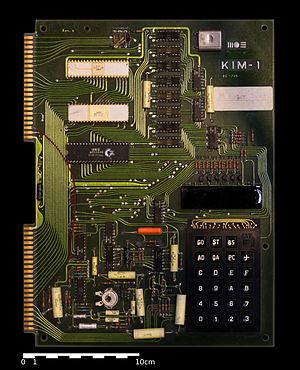KIM-1

|
|
| Developer | Chuck Peddle |
|---|---|
| Manufacturer | MOS Technology, Inc. |
| Type | single-board computer |
| Release date | 1976 |
| CPU | 6502 |
The KIM-1, short for Keyboard Input Monitor, was a small 6502-based single-board computer developed and produced by MOS Technology, Inc. and launched in 1976. It was very successful in that period, due to its low price (following from the inexpensive 6502) and easy-access expandability.
MOS Technology's first processor, the 6501, could be plugged into existing motherboards that used the Motorola 6800, allowing potential users (i.e. engineers and hobbyists) to get a development system up and running very easily using existing hardware. Motorola immediately sued, forcing MOS to pull the 6501 from the market. Changing the pin layout produced the "lawsuit-friendly" 6502. Otherwise identical to the 6501, it nevertheless had the disadvantage of having no machine in which new users could quickly start playing with the CPU.
Chuck Peddle, leader of the 650x group at MOS (and former member of Motorola's 6800 team), designed the KIM-1 in order to fill this need. The KIM-1 came to market in 1976. While the machine was originally intended to be used by engineers, it quickly found a large audience with hobbyists. A complete system could be constructed for under 500 US$ with the purchase of the kit for only 245 US$, and then adding a power supply, a used terminal and a cassette tape drive.
Many books were available demonstrating small assembly language programs for the KIM, including "The First Book of KIM" by Jim Butterfield et al. One demo program converted the KIM into a music box by toggling a software-controllable output bit connected to a small loudspeaker.
As the system became more popular one of the common additions was the Tiny BASIC programming language. This required an easy memory expansion; "all of the decoding for the first 4 K is provided right on the KIM board. All you need to provide is 4 K more of RAM chips and some buffers." The hard part was loading the BASIC from cassette tape—a 15-minute, error-prone ordeal.
...
Wikipedia
